
Labradorite Aboɔden abo: Nneɛma, Nkyerɛase, Botae & Nea Ɛkeka Ho
 Labradorite yɛ feldspar aboɔden abo a wonim no sɛ ɛda emu iridescence a ɛyɛ nwonwa a wɔfrɛ no “labradorescence,” adularescence bi adi. Ɛtɔ mmere bi a wɔfrɛ saa ade yi “ schiller .”
Labradorite yɛ feldspar aboɔden abo a wonim no sɛ ɛda emu iridescence a ɛyɛ nwonwa a wɔfrɛ no “labradorescence,” adularescence bi adi. Ɛtɔ mmere bi a wɔfrɛ saa ade yi “ schiller .”
Yɛpa wo kyɛw akraman adɔfo, nanso wɔamfa akraman abusua no din ato labradorite. Mmom no, wɔde Labrador, Canada, din ato so. Nokwarem no, labradorite ne Labrador ne ne mantam, Newfoundland, aboɔden abo a aban de di dwuma.
Ebia wubehu “feldspar” afi aboɔden abo afoforo a ɛwɔ abusua yi mu te sɛ amazonite , orthoclase, owia abo , ne ɔsram abo mu. Owia abo pii bu no sɛ labradorite ankasa! Nhwɛso a ɛte saa no biako ne Oregon owia abo a ɛkyerɛ dade bi a ɛhyerɛn a wɔfrɛ no aventurescence. After orthoclase , labradorite ne feldspar aboɔden abo a wobɛtaa ahu sɛ ɛyɛ faceted.
Sɛ Oregon owia abo da nkyɛn a, labradorite wɔ ahorow nketenkete afoforo kakraa bi. Ɛnnɛ, yɛbɛka saa ahorow no ho asɛm, ne labradorite su ahorow, ayaresa a wɔde di dwuma, sɛnkyerɛnne kwan so nneɛma, ne wo nsɛmmisa afoforo nyinaa a ɛfa labradorite aboɔden abo ho!
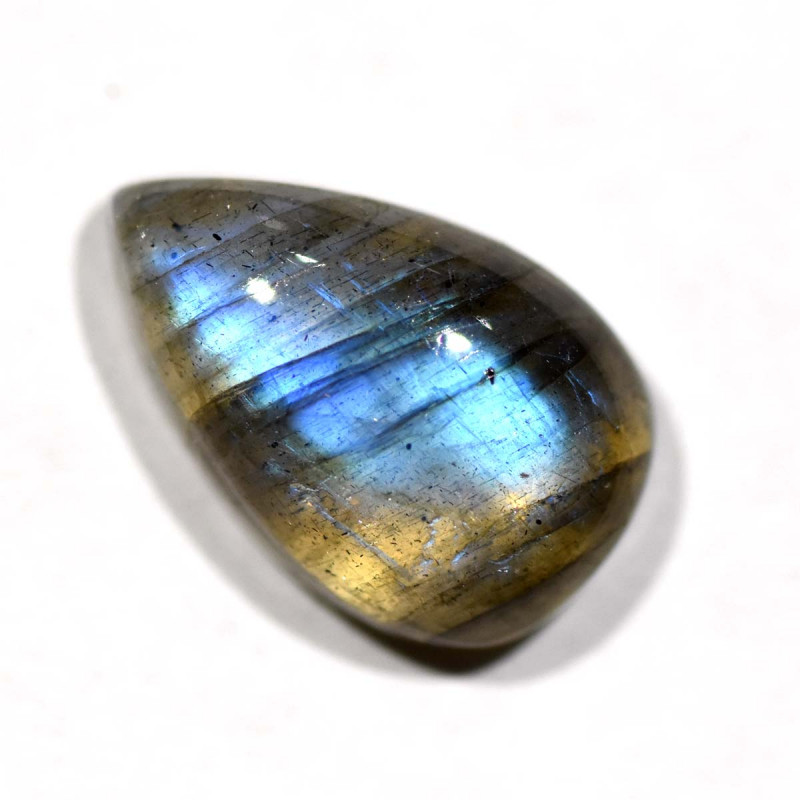
Ɛfa Labradorite Ɔbo ho
Nea edi kan no, so labradorite yɛ aboɔden abo a ɛsom bo? Dabi, labradorite yɛ aboɔden abo a ɛsom bo fã bi . Aboɔden abo a wobu no sɛ “aboɔden abo a ɛsom bo” nkutoo ne abohene , safir , aboɔden abo , ne emerald . Nanso, labradorite betumi ayɛ talisman a ɛyɛ anigye!
Awoɔ bo bɛn na ɛyɛ labradorite? Labradorite yɛ November awobo foforo ne awobo a ɛyɛ nwonwa ma wɔn a wɔwoo wɔn Kwasida.
Wɔ nsoromma mu hwɛ mu no, labradorite nsoromma mu hwɛ abo yɛ Kokoram sɛnkyerɛnne no fɛ, na labradorite ahorow spectrolite no yɛ anigye ma Scorpio, Sagittarius, ne Leo. Labradorite okyinnsoromma no ne Uranus anaa Pluto, ɛwom sɛ nsoromma mu ahwɛfo binom kamfo kyerɛ sɛ wɔnhyɛ labradorite wɔ Venus mmere atitiriw mu de.
Aboɔden abo Su ahorow
Labradorite yɛ anorthite plagioclase feldspar aboɔden abo a sodium, calcium, aluminium, ne silicon na ɛwom. Sodium a ɛwɔ mu no gu ahorow fi ɔha biara mu nkyem 30-50 na ne calcium nso gu ahorow fi ɔha biara mu nkyem 50-70. Ɔbo no yɛ anorthite ne albite feldspar, nanso nea ɛwom no yɛ ɔha biara mu nkyem 50-70 anorthite na ɔha biara mu nkyem 30-50 pɛ na ɛyɛ albite.
Feldspar mineral abusua no yɛ nea ɛyɛ den, nanso akuw abien a ɛtaa ba ne plagioclase ne alkali feldspars. Wɔ plagioclase feldspars mu no, labradorite nkutoo ne aboɔden abo a ɛda schiller a emu yɛ den adi.
Wɔ Mohs mineral hardness scale , labradorite di kan fi 6 kosi 6.5. Labradorite abo taa yɛ fitaa, fitaa, kɔkɔɔ, anaa kɔla biara, nanso wɔn labradorescence ne baabi a ɛhyerɛn ankasa — ankasa! Kɔla biara a ɛwɔ nyankontɔn no mu betumi ahyerɛn afi labradorite mu, nanso bruu ne borɔdɔma na ɛtaa ba.
Ade biako a ɛho hia a ɛsɛ sɛ yɛhyɛ no nsow: Ɛnyɛ labradorite abo nyinaa na ɛkyerɛ labradorescence. Ebia ebinom nkyerɛ aniwa so nkɛntɛnso biara, bere a afoforo nso betumi ada aventurescence a ɛyɛ bruu-fitaa nkutoo adi.
Sɛ yɛreka ahorow ahorow ho asɛm a, momma yɛnkɔ labradorite ahorow nketewa no so!
 Mfonini a ɛwɔ atifi hɔ no: spectrolite
Mfonini a ɛwɔ atifi hɔ no: spectrolite
Labradorite ahorow ahorow
Labradorite ahorow abiɛsa na ɛda nsow: spectrolite, andesine-labradorite, ne nyankontɔn ɔsram abo.
Spectrolite a wɔde yɛ nneɛma . Aguadi din a wɔde frɛ Finlandfo labradorite ahorow a wɔntaa nhu a ɛwɔ kɔla ahorow a ɛyɛ hyew a ɛte sɛ Atifi Fam Kanea a ɛyɛ nyankontɔn a ɛyɛ pɛ no.
Andesine-Labradorite a ɛwɔ hɔ no . Andesine ne labradorite a wɔde afrafra a ɛyɛ bruu, peach, orange, anaa kɔkɔɔ a ɛnyɛ hann a wodii kan huu wɔ afe 2003. Ebia ɛkyerɛ labradorite a wɔde kɔla ayɛ kɛse nso.
Rainbow Ɔsram Abo . Labradorite fitaa a ɛyɛ translucent kosi transparent a ɛwɔ schiller a ano yɛ den na ɛyɛ bruu a wohu wɔ Madagascar, na ɛma wɔto din “Madagascar Moonstone.”
So labradorite yɛ ɔsram bo? Ɛmfa ho sɛ wɔde nyankontɔn ɔsram abo din a ɛdaadaa nkurɔfo no, labradorite ne ɔsram abo yɛ aboɔden abo ahorow. Wɔn baanu nyinaa yɛ feldspar minerals a ɛwɔ iridescence nanso ɛsono wɔn wɔ akwan titiriw abien so:
Nneɛma a wɔahyehyɛ : Labradorite yɛ plagioclase feldspar, na ɔsram abo yɛ orthoclase feldspar a ɛyɛ aboɔden abo.
Optical Effect : Wonim Labradorite sɛ ɛyɛ iridescence ahorow a ɛwɔ mu, bere a ɔsram abo wɔ iridescence a ɛte sɛ nufusu wɔ mu wɔ bruu anaa fitaa nkutoo mu.
Kenkan labradorite asase ho nneɛma a aka no wɔ ase ha!
Labradorite Nkyerɛkyerɛmu & Su ahorow
Kɔla : Mpɛn pii no, enni kɔla, fitaa, kɔkɔɔ, anaa fitaa; Ebia ɛbɛkyerɛ kɔla kɔkɔɔ, borɔdɔma, kɔkɔɔ, ahabammono, bruu, ne violet a ɛhyerɛn a ɛyɛ labradorescence
Ahwehwɛ nhyehyɛe : Triclinic
Luster : Ɛyɛ ahwehwɛ anaasɛ vitreous (te sɛ ahwehwɛ) .
Transparency : Ɛyɛ nea ɛda adi pefee kosi nea ɛnyɛ nea ɛda adi pefee
Nneɛma a ɛma nneɛma yɛ mmerɛw : 1.52-1.57
Nnipa dodow : 2.68-2.72
Cleavage : Ɛyɛ pɛpɛɛpɛ wɔ akwan abien so
Fracture : Ɛnyɛ pɛpɛɛpɛ
Streak : Ɛyɛ fitaa
Luminescence : Ebia ɛbɛda fluorescence adi; kɔkɔɔ wɔ SW-UV mu, bruu a ɛyɛ hann anaa violet-blue wɔ LW-UV mu
Pleochroism : Ɛwɔ hɔ na ɛda nsow wɔ Oregon labradorite mu
Wunim mineralogy no, nanso dɛn ne labradorite ahwehwɛ no kyerɛ?
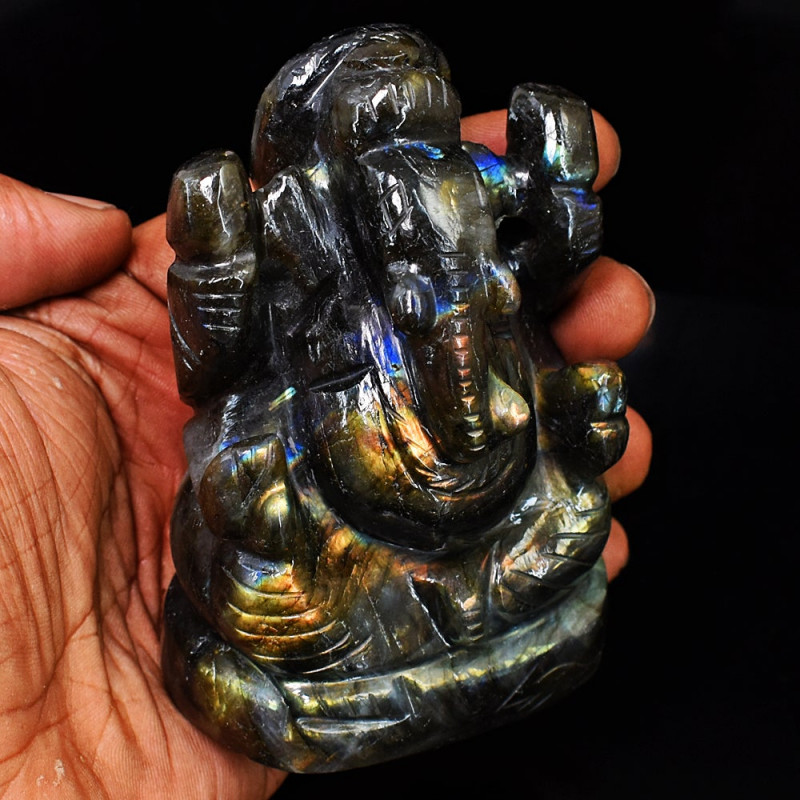
Labradorite Nkyerɛaseɛ
Labradorite din no fi baabi a wodii kan huu no wɔ 1770 mu: Labrador, Canada. Nea Labradorite kyerɛ wɔ honhom fam no ama wɔato abodin te sɛ “Nkrabea Ɔbo” ne “Aurora Borealis Aboɔden abo.”
Enti, dɛn na labradorite yɛ ho sɛnkyerɛnne? Labradorite yɛ nsakrae ho sɛnkyerɛnne, titiriw bo a wosi ne ahoɔden a ehia bere a wɔrefa nsakrae mu no. Wɔkyerɛ nso sɛ spectrolite gyina hɔ ma “Nsoromma Asɔredan,” tete dan bi a wɔkyerɛ sɛ ɛwɔ England a ɛyɛ nsoromma ho mfonini.
Wɔ saa nkyerɛwde no so no, labradorite wɔ anansesɛm bi a atwa ho ahyia. Inuit labradorite anansesɛm bi ka sɛ na Atifi Fam Hann (Aurora Borealis) no akɔhyɛ labradorite mu, na wɔretwɛn sɛ Inuit ne Beothuk nkurɔfo behu wɔn sɛnea ɛbɛyɛ a wobetumi agyae wɔn akɔ wim.
Wɔto Finland spectrolite din “Hann Ɔbo” na anansesɛm ahorow ka sɛ ɛde nkate, ahotoso, ne anigye kɛse ba. Finlandfo binom gye di sɛ labradorite gyina hɔ ma nyankontɔn “Bifrost Bridge” a ɛka Asase ne Asgard, baabi a anyame te wɔ Norsefo anansesɛm mu no bom.
Yenim nea ɛkyerɛ wɔ honhom fam, nanso dɛn na labradorite yɛ wɔ honhom fam? Momma yɛnhwɛ labradorite ahwehwɛ su ahorow a ɛma ɛsa yare.
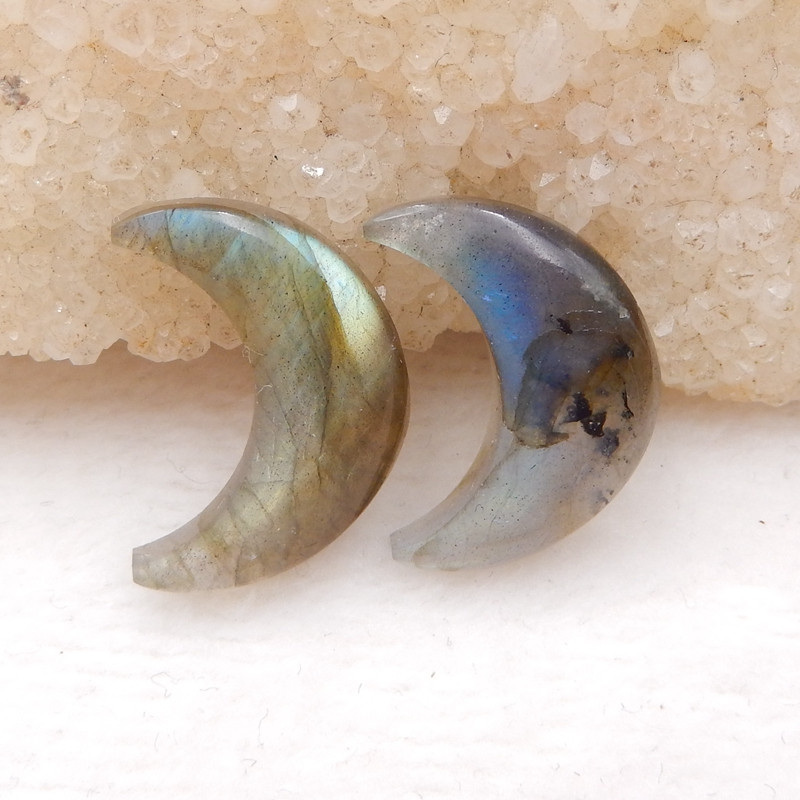
Labradorite Ayaresa Nneɛma
Aboɔden abo nyinaa wɔ ahoɔden a ɛma ɛyɛ abo a wɔde sa yare a mfaso wɔ so , na labradorite ka ho! Bere a aboɔden abo a ɛyɛ bruu titiriw a ne kɔla hyerɛn no, labradorite fi awosu mu de ahoɔden a ɛma ahomegye ba de hohoro dadwen fi hɔ.
Sɛ yɛka ne nyinaa bom a, wɔka sɛ labradorite ahwehwɛ yɛ ɔwɛmfo a ɛbɔ ne ho ban, na ɛbɔ nneɛma bɔne ho ban wɔ akyi ne emu nyinaa. Ebinom ka sɛ ɛma wo ho a wobɛsɛe no no yɛ mmerɛw, na ɛma wutumi di w’adaeso ahorow akyi.
Sɛ wopɛ ayaresa pɔtee bi a, dɛn na wɔde labradorite ɔbo di dwuma?
Nipadua mu Ayaresa
Wɔbɔ amanneɛ sɛ wɔ nipadua mu no, labradorite boa ma wɔsa amemene ne aniwa mu yare ne mogya mmoroso. Mfaso afoforo a wɔkyerɛ sɛ ɛwɔ so ne sɛ ɛbɛtew awɔw ho nkate so, ɛma ɛyaw a ɛba brayɛ mu no so tew, na ɛboa ma wɔyam aduan yiye.
Nkate mu Ayaresa
Ebia nea ɛka nkate mu ayaresa a wɔde labradorite di dwuma ho ne ehu a wɔbɛtew so, adwennwen a wɔbɛtew so, na wɔama wɔn ankasa bo ayɛ den. Labradorite nso betumi ama wo nipasu su a eye sen biara no ayɛ kɛse!
Mfaso a Labradorite nya wɔ adwumam no betumi atew nitan so na ahyɛ tema ho nkuran, na ama wɔanya tebea a ɛma akwaaba kɛse, a wɔbom yɛ adwuma.
Chakra Ayaresa
Labradorite chakra abo yɛ adwuma yiye wɔ aniwa (brow) chakra anaa menewa chakra a ɛto so abiɛsa no ho.
Aniwa chakra a ɛto so abiɛsa no ne baabi a wote wiase no ase wɔ ɔkwan a emu dɔ, honhom fam. Sɛ wɔasiw ano a, ebia wobɛte nka sɛ wonyɛ hwee anaasɛ woreyɛ ho biribi. Labradorite betumi abue bio, na ɛde nhumu ne abusuabɔ a ɛda ɔsoro nyansa ntam abrɛ wo.
Menewa chakra no na ɛkyerɛ sɛnea wote wo ho ase na wo ne afoforo di nkitaho. Dadwen anaa fɛre a wobɛte nka no yɛ sɛnkyerɛnne a ɛkyerɛ sɛ woasiw kwan. Sɛ wode labradorite bue chakra no wie a, wubetumi anya wo ho nimdeɛ kɛse ne nkitahodi a ɛnyɛ den.
Seesei a wunim nea enti a ɛsɛ sɛ wohyɛ labradorite de sa yare no, momma yensusuw nea ɛsɛ sɛ wohwehwɛ bere a woretɔ labradorite agude ho.

Labradorite Aboɔden Aboɔ Nneɛma a Ɛwɔ Hɔ
Abenfo gyina nneɛma a ɛsom bo anaa aboɔden abo no su so na ɛkyerɛ bo a ɛsom bo. Labradorite nneɛma bi ne kɔla/iridescence, pefeeyɛ/transparency, twa, ne ayaresa.
Kɔla & Iridescence a Ɛyɛ Fɛ
Labradorite nipadua kɔla taa yɛ mfimfini kosi tuntum a ɛyɛ fitaa, tuntum, anaa bruu. Akyi a ɛyɛ tumm no ma nsonsonoe a ɛda adi pefee ma iridescence no hyerɛn.
Kɔla ahorow a ɛtaa yɛ iridescence wɔ labradorite mu ne bruu ne ahabammono, ɛwom sɛ ebia wubehu kɔkɔɔ, borɔdɔma, anaa kɔkɔɔ nso de. Kɔla a ɛho yɛ na (na ne bo yɛ den) a ɛhyerɛn no yɛ kɔkɔɔ, fitaa, ne kɔbere a ɛyɛ pink.
Iridescence a ne bo yɛ den sen biara no yɛ nea ɛkɔ so daa, ɛyɛ ma, na egu ahorow wɔ kɔla ahorow mu. Ɛtɔ mmere bi a, labradorescence wɔ “anifurae” tumi, baabi a ɛte sɛ nea hann a ɛhyerɛn no hyɛn mu na efi mu bere a wɔde ɔbo no tu no.
Nea enti a labradorite yɛ iridescence no ba fam wɔ nea ɛka ho no so.
Nsɛm a ɛda adi pefee & Nsɛm a ɛda adi pefee
Labradorite pefee (dodow ne nea wotumi hu a ɛka ho) hyɛ Type II kɔla aboɔden abo a emu da hɔ grade ase , a ɛkyerɛ sɛ wobɛtaa ahu nneɛma bi a wotumi hu. Labradorite a ɛka ho no boa ma ɛyɛ agoru a ɛyɛ kɔla, bere a hann fi efĩ nketenkete a ɛwɔ ntoatoaso mu ba no.
Nneɛma a wɔtaa de ka ho ne zircon, magnetite, rutile abopon, ne ilmenite. Wɔ labradorite a enni kɔla na ɛyɛ mmerɛw mu no, wobɛtaa ahu nneɛma a ɛyɛ tumm a ɛte sɛ asaawa a wɔde ka ho.
Labradorite abo dodow no ara yɛ nea ɛyɛ hann kosi nea ɛnyɛ hann. Nea ɛyɛ anigye no, opaque ne transparent labradorite gems nyinaa nkyerɛ labradorescence yiye, enti translucent nhwɛsode ahorow ye sen biara.

Twa
Ebia wɔde labradorite nhwɛsode ahorow a ɛyɛ mmerɛw no afã horow ama hyerɛn a eye sen biara, dodow no ara wɔ kurukuruwa anaa kurukuruwa a wɔatwitwa mu. Nanso, labradorite taa dan cabochons , nsusuwso , anaa nhwiren . Wobetumi atwitwa anorthosite abotan a Labradorite pii wom no ayɛ no abopon de adi dwuma wɔ adansi mu.
Enti, sɛ yesusuw labradorite anuonyam a agye din sɛ abohene a ɛwɔ kɔla ahorow a ɛyɛ hyew no ho a, so ne kɔla ahorow no yɛ abɔde mu de anaasɛ wɔayɛ ho adwuma?
Ayaresa ahorow
Ebia agudeyɛfo betumi de ayaresa abien adi dwuma ama labradorite: diffusion ne lattice diffusion.
Nea ɛka diffusion ayaresa ho ne sɛ wɔbɛma nnuru akɔ ɔbo no ani bere a wɔde hyew no wɔ fononoo mu, mpɛn pii no dapɛn biako anaa nea ɛte saa. Ɛkame ayɛ sɛ lattice diffusion yɛ ade koro, nanso nnuru mu nneɛma hyɛn ɔbo no mu wɔ atom kwan so. Ayaresa abien no nyinaa ma wonya kɔla a ɛyɛ dɛ anaa foforo, nanso lattice diffusion no gyina pintinn.
Ɛsɛ sɛ wɔda aboɔden abo ayaresa adi kyerɛ nea ɔtɔ no bere nyinaa, nanso sɛ ɛhaw wo sɛ wɔkyerɛw wo aboɔden abo a “wɔansa” no din wɔ ɔkwan a ɛnteɛ so a, wubetumi asɔ ahwɛ sɛ ebia wɔde aduru a ɛma ɛtrɛw anaa .

Labradorite Abakɔsɛm
Bere tenten a atwam ni no, na Red Paint People of Maine, kuw bi a na wɔwɔ Amerika Atifi fam Apuei mpɔtam hɔ ansa na wɔreba no nim labradorite. Wɔn a wotutu fam hwehwɛ tetefo nneɛma mu huu labradorite nneɛma a ɛwɔ hɔ ansa na afe 1000 Y.B.
Labradorite a aban mpanyimfo huu nea edi kan no sii wɔ St. Paul Supɔw so wɔ 1770 mu bere a Moravia asɛmpatrɛwfo huu ɔbo no wɔ baabi a ɛbɛn Nain no. Nanso, adanse bi wɔ hɔ a ɛkyerɛ sɛ na tete Inuit mmusuakuw nim labradorite ansa na wɔrehu no.
Spectrolite a wohuu no sii wɔ 1940. Finland asase ho nimdefo ne ɔbenfo Aarne Laitakari hwehwɛɛ mfe du du pii hwehwɛɛ Finlandfo labradorite “ɛna ɔbotan” no nanso ankosi hwee. Wɔ WWII mu no, na Laitakari babarima Pekka resi abannennen wɔ Ylämaa bere a ɔto hintidua wɔ spectrolite a edi kan a wonim sɛ ɛwɔ hɔ no so no.
Pekka de nhwɛsode foforo no kɔmaa Aarne, na osii so dua sɛ ne hwehwɛ a ɔhwehwɛɛ “ɛna ɔbotan” no anyɛ ɔkwa. Walter Mikkola a ɔyɛ agude ho ɔbenfo no de edin “spectrolite” (a ɛkyerɛ ɔbo no kɔla ahorow) ho nyansahyɛ maa Ɔbenfo Laitakari.
Akyiri yi wɔ 1975 mu no, Newfoundland ne Labrador mpanyimfo paw labradorite sɛ wɔn aboɔden abo a aban mpanyimfo yɛ. Wɔ 1988 mu no, Finland Nsrahwɛfo Bagua no too spectrolite din sɛ South Karelia Mantam no mantam mu ɔbo.
Abakɔsɛm a ɛyɛ anigye bɛn ara ni! Nanso ansa na wobehu no, ɔkwan bɛn so na labradorite yɛ?
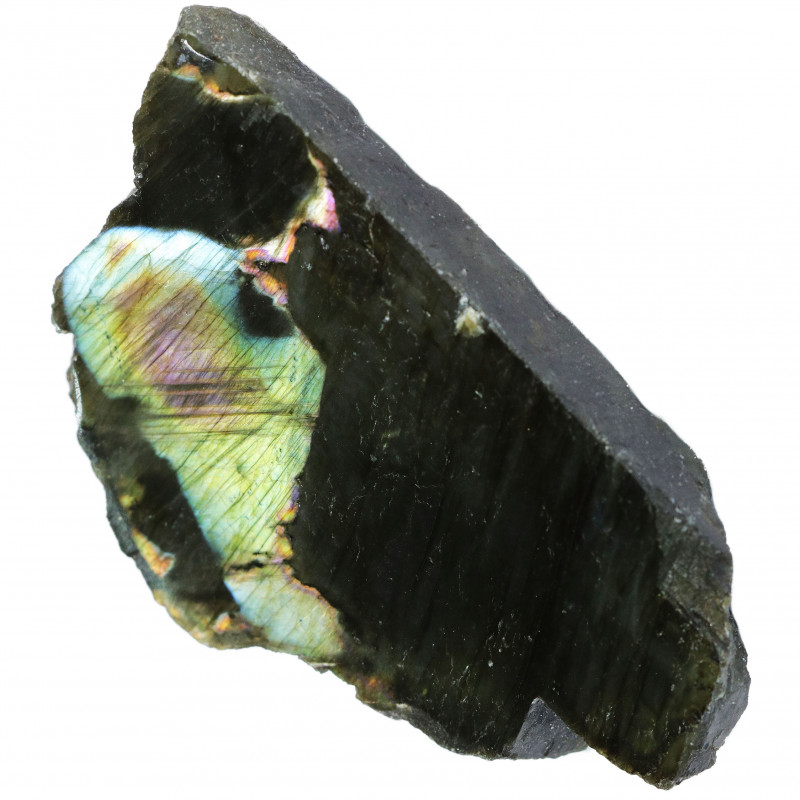
Labradorite Abo Mfiase & Fibea
Labradorite abo a wɔannoa no ba wɔ abotan ahorow abiɛsa no nyinaa mu: igneous, metamorphic, ne sedimentary. Mpɛn pii no, labradorite wɔ basalt, gabbro, norite, anaa anorthosite, ɔbotan a ɛkame ayɛ sɛ labradorite na ɛyɛ ne nyinaa mu.
Abotan a ɛyɛ ogya a ɛwɔ labradorite te sɛ anorthosite betumi adan gneiss, labradorite fibea foforo, anaasɛ ɛbɛfa wim tebea mu de ayɛ nsu a ɛyɛ fĩ wɔ baabi a wohu labradorite nso.
Bere a labradorite wɔ ahwehwɛ nhyehyɛe no, ɛntaa nyɛ ahwehwɛ a ɛyɛ ma. Mpɛn pii no, wɔn a wotu fam no hu labradorite wɔ asinasin anaa asinasin mu. Nanso, ɔbo no ahwehwɛ nhyehyɛe no ho hia kɛse ma labradorescence a wɔda no adi.
Ɔbo no yɛ ntoatoaso a ɛyɛ tratraa a wɔaboaboa ano denneennen. Sɛ hann bɔ ɔbo no a, nsensanee no twetwe hann no, ɛtrɛw, anaasɛ ɛdannan, na ɛsan hyerɛn ma yɛn wɔ kɔla ahorow mu.
Sɛ ɛba wie a, ɛhe na wohu labradorite?
Mmeae a Wɔtu Tuo
Mprempren, Madagascar na labradorite fibea dɔɔso sen biara. Finland, Canada, ne USA nyinaa wɔ sika a wɔde asie a ɛho hia, nso. Nhwɛsode a wɔntaa nhu a ɛda adi pefee no fi Oregon (U.S.A.) ne India.
Labradorite mpɔtam afoforo bi ne:
Australia
China
France
Germany
Greenland na ɛwɔ hɔ
Iceland na ɛwɔ hɔ
Italy
Japan
Norway
Russia
Slovakia na ɛwɔ hɔ
Spain
Sri Lanka na ɛwɔ hɔ
U.S.A.: Arizona, California, Maine, Nevada, Mexico Foforo, Oregon, Utah
United Kingdom na ɛwɔ hɔ
Saa ɔbo yi wɔ nnipa pii a wɔyɛ, nanso so labradorite bo yɛ den?
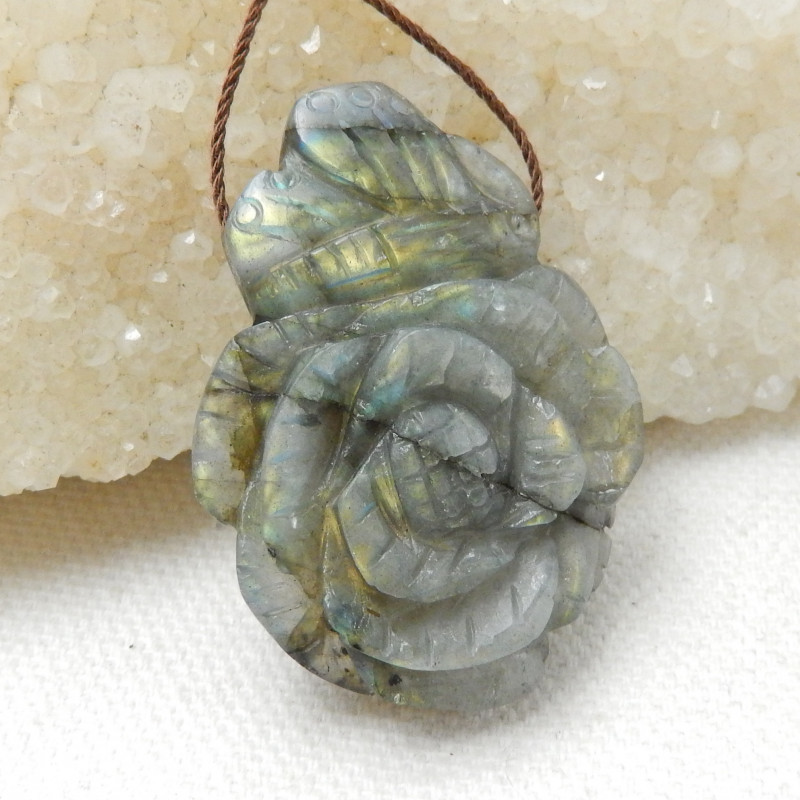
Labradorite Bo & Ne Bo
Sɛ́ aboɔden abo no, Labradorite dɔɔso, nanso nneɛma a wotu no mu dodow no ara nyɛ aboɔden abo. Labradorite agude dodow no ara nso yɛ amanne, ɛnyɛ nea wɔyɛ no pii, a ɛkyerɛ sɛ ne bo kɔ soro.
Sɛ woresusuw labradorite aboɔden abo bo a ɛsom ho a, hwehwɛ sɛnea ɛyɛ iridescent pefee, kɔla ahorow a ɛyɛ ma, kɔla ahorow pii, ne akyi a ɛyɛ tumm. Labradorite a ɛyɛ papa a ɛbɔ saa agyiraehyɛde ahorow yi taa yɛ dɔla 40 wɔ carat biara mu anaa nea ɛboro saa.
Labradorite bo a wɔbɔ wɔ carat biara ho no sua ma abo a ɛwɔ labradorescence bruu, na wɔtɔn saa cabochons yi $2-$5 carat biara. Red labradorescence ho yɛ na koraa, ɛtɔ mmere bi a wɔtɔn no dɔla 1,000 wɔ carat biako anaa nea ɛboro saa!
Sɛ woresusuw sɛnea wubehu labradorite ɔbo a ɛnyɛ nokware ho a, hwehwɛ iridescence no mu bere a woredi akɔneaba no. Sɛ kɔla a ɛhyerɛn no pue wɔ afã biara a, ebia ɛyɛ atoro.
Labradorite Hwɛ ne Nsiesiei
Labradorite mfinimfini denden ne cleavage a edi mũ kyerɛ sɛ ɛsɛ sɛ wode ahwɛyiye di ho dwuma. Sɛ wobɔ labradorite mpɛtea wɔ baabi a ɛfata a, ebetumi abubu ɔbo no, enti hwehwɛ agude a wɔde nneɛma a ɛbɔ ho ban .
Sɛ wopɛ sɛ wohohoro labradorite ho a, fa samina a ɛnyɛ den, nsu a ɛyɛ hyew, ne brɔs a ɛyɛ mmerɛw di dwuma. Afei hohoro mu, fa ntama a wɔde microfiber ayɛ no ma ɛyow, na fa sie wɔ ɔkwan soronko so wɔ aboɔden abo afoforo ho.
Yi labradorite agude ansa na woayɛ adwuma biara — ahotew, aduruyɛ, ne nea ɛkeka ho — a ebetumi ama nnuru a ɛsɛe ade ada no adi.

Woasiesie Wo Ho sɛ Wobɛnya Labradorite Anigye?
Sɛ yɛhwɛ labradorite iridescence soronko ne lore a ɛyɛ fɛ a, ɛnyɛ nwonwa sɛ agude adwumfo yɛ no asinasin a ɛyɛ fɛ. Wubetumi de labradorite abantenten a ɛwɔ wo dan mu anaasɛ labradorite ahwehwɛ kɔnmuade abɔ wo kɔn mu ato nsa afrɛ ahotoso ne adwempa aba w’asetra mu!
Sɛnea wode bedi dwuma biara no, labradorite yɛ ɔhokafo a ɛbɔ wo ho ban na ɔhyɛ nkuran a ɛkae wo sɛ aprannaa ne ahokyere kyerɛ sɛ nyankontɔn bi abɛn.
搜尋Gemstone Encyclopedia
相關拍賣
相關文章
Momma yɛnkyerɛkyerɛ sɛnea wɔtɔ aboɔden abo wɔ intanɛt so. Yɛwɔ aboɔden aboɔ a ɛso sen biara wɔ intanɛt so na ɛbɛtumi ayɛ den kakra wɔ mfitiaseɛ no. Ma yɛmfa afotu bi a mfaso wɔ so mmoa wo.
3rd Oct 2018
W’aboɔden abo a wobɛhwɛ so no boa ma ɛyɛ fɛ wɔ wo nkwa nna nyinaa mu. Yɛbɛka nneɛma te sɛ denden ne ayaresa ho asɛm, ne anammɔn a ɛfa sɛnea wobɛhohoro wo aboɔden abo na wode asie dwoodwoo ho.
9th May 2018
So woasusuw sɛnea wɔyɛ Ruby aboɔden abo ho pɛn? Ayaresa ahorow pii wɔ gua so na yɛbɛboa ma yɛakyerɛkyerɛ mu
9th May 2018
最新的文章
Nnua a wɔde asonse a wɔasen a wɔsan frɛ no nhabannuru asonse no yɛ abɔde mu ade a wɔde si asono asonse ananmu, na wotwa fi Amerika Kesee Fam phytelephas nnuadewa mu nnuadewa mu wɔ abrabɔ pa mu. Sua mmɛw asonse ho ade nyinaa wɔ akwankyerɛ yi mu!
15th Jan 2026
Chrysanthemum nhwiren abo yɛ abɔde mu anwonwade a ɛwɔ calcite, celestite, anaa andalusite nhwiren fitaa bi a wɔde asisi limestone tuntum anaa atɛkyɛ abo so.
13th Jan 2026
Rainbow lattice sunstone yɛ feldspar ahorow a ɛwɔ optical nsunsuanso abiɛsa fɛfɛ a efi nneɛma ahorow a wɔde ka ho a ɛwɔ hɔ no mu ba. Ɛyɛ ogya kɔla display ne lattice nsusuwso ma ɛyɛ coletor abohene a wɔntaa nhu!
12th Jan 2026
文章類別
How To's is where you will find helpful articles from gem Rock Auctions on how to cut gemstones, select gemstones and buy gemstones.
9文章






